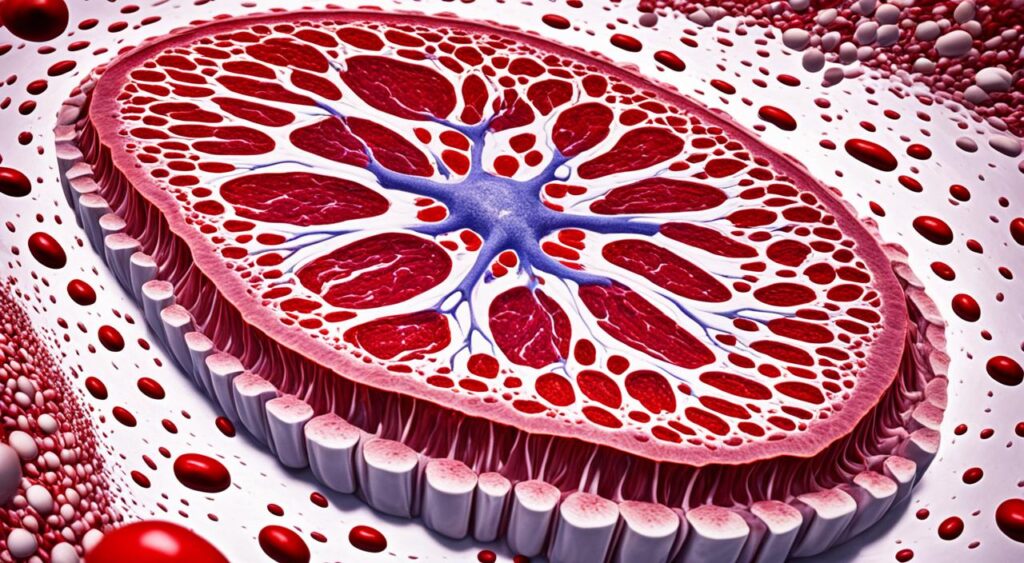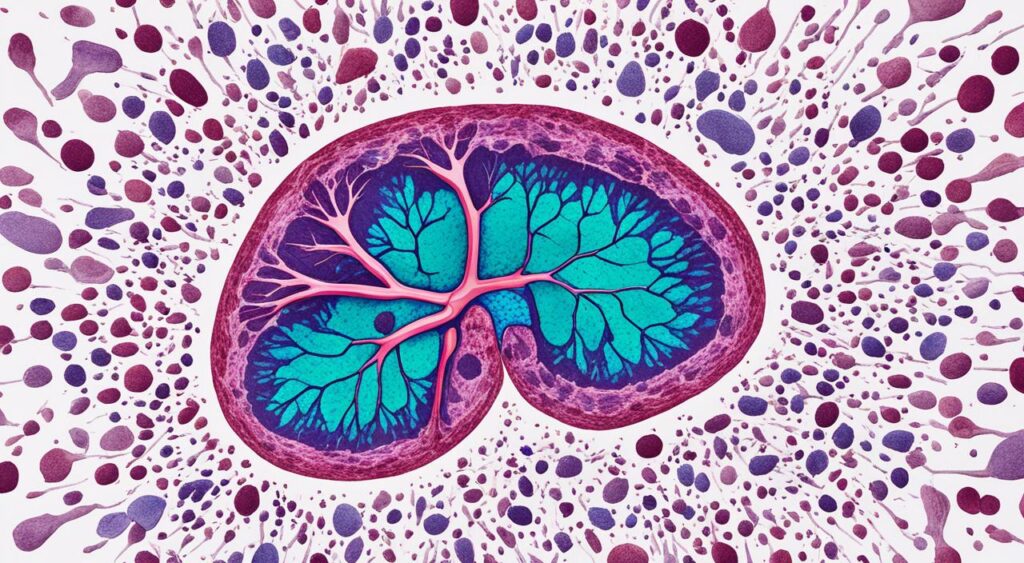The liver is crucial for our body to function well. It can face many issues, from fatty liver disease to liver cancer. These problems can happen slowly over time.
Some diseases, like hepatitis C, can be cured. But diseases such as liver cirrhosis cannot be fully cured. Still, they can be managed with the right treatment.
Left untreated, liver diseases can lead to serious issues like liver failure and cancer. This is why it’s so important to know what causes these problems.
Key Takeaways
- Liver disease can have various underlying causes, including viral infections, excessive alcohol consumption, and autoimmune disorders.
- Liver disease can progress slowly, with some types being curable and others requiring ongoing management.
- Untreated liver disease can lead to severe complications, such as liver failure and liver cancer.
- Prompt diagnosis and appropriate treatment are crucial in managing liver diseases effectively.
- Liver diseases can affect both adults and children, with different types and potential complications in each age group.
Liver Diseases: An Overview
The liver is a vital organ that does many important jobs in the body. It helps change nutrients into necessary chemicals. It also filters toxins and helps with energy from food. A healthy liver is key to the body’s overall health cause liver.
The Liver’s Vital Functions
The liver is a vital organ for our health. It changes nutrients and cleans the blood from harmful substances. The liver also makes bile to digest fats. Without a working liver, the body can face serious problems drink alcohol.
Types and Prevalence of Liver Diseases
Many liver diseases exist, each caused by different things. Hepatitis, cirrhosis, and alcohol-related liver diseases are common. Issues like autoimmune liver diseases and liver transplantation are also big concerns chronic liver disease.
Viral Hepatitis: A Common Culprit

Viral hepatitis is a leading cause of liver problems. It comes in several types. It’s vital to know these types to tackle and avoid liver issues American liver foundation.
Hepatitis A
Hepatitis A spreads through tainted food or water. It usually goes away on its own within 6 months. This infection rarely causes ongoing liver illness.
Hepatitis B
Hepatitis B spreads through infected fluids like during sex or shared needles. If not treated, it can lead to long term liver disease types of liver problems. It also raises your chance of liver cancer.
Hepatitis C
Hepatitis C enters the body through the hepatitis C virus, often linked to IV drug use or bad medical procedures. Like hepatitis B, Hepatitis C can turn into longstanding liver problems if not addressed alcohol use.
| Type of Viral Hepatitis | Transmission | Potential Complications |
|---|---|---|
| Hepatitis A | Eating or drinking contaminated items | Often clears within 6 months with no lasting damage |
| Hepatitis B | Coming into contact with infected body fluids | May lead to lifelong liver issues, ups risk of liver cancer |
| Hepatitis C | From infected blood, frequently by IV drug use or risky medical processes | Can cause chronic liver problems if not treated |
Alcohol-Associated Liver Disease
Alcohol-associated liver disease groups several liver conditions. They’re all due to drinking too much alcohol. It starts with alcohol-associated fatty liver. This happens when excessive alcohol harms liver cells. Then, it can turn into alcohol-associated hepatitis. This stage adds inflammation and more liver damage. The final stage is alcohol-associated cirrhosis. Here, the liver gets scarred, making it hard for the liver to work right liver disease progresses.
Alcohol-Associated Fatty Liver
The first stage is alcohol-associated fatty liver. This happens when the liver gets too much fat from alcohol. The liver grows bigger, which can mess up how it works liver disease caused.
Alcohol-Associated Hepatitis
Drinking too much can lead to alcohol-associated hepatitis. This makes the liver inflamed and damaged. It starts struggling more to do its job end-stage liver disease.
Alcohol-Associated Cirrhosis
Alcohol-associated cirrhosis is the worst stage. Lots of scar tissue forms. The liver can’t work right anymore. This brings serious problems like liver failure and a higher danger of liver cancer liver is damaged.
Nonalcoholic Fatty Liver Disease (NAFLD)

Nonalcoholic fatty liver disease (NAFLD) is common. It means there is too much fat in the liver, even without much alcohol. A form of NAFLD, called nonalcoholic steatohepatitis (NASH), brings liver swelling and cell harm. This can lead to liver scarring (fibrosis) and severe liver diseases treating liver disease.
NAFLD often links to obesity, type 2 diabetes, and high cholesterol. The main causes of NAFLD aren’t fully clear, but they involve genes, the environment, and lifestyle. Staying at a healthy weight, managing diabetes and other issues, and eating well with exercise can lower NAFLD risks need a liver transplant.
Early NAFLD stages might not show clear signs. But, it can get worse over time, leading to severe liver problems if not treated. This is why watching it closely and acting early are key to stop NASH and its harms, like cirrhosis and liver failure.
The spread of NAFLD is growing because of obesity and metabolism issues. So, healthcare workers need to check and treat NAFLD in those at risk. Changing lifestyles and sometimes using specific medical care can slow or end NAFLD’s progress. Finding it early and acting fast is very important liver disease and cirrhosis.
Autoimmune Liver Diseases

Autoimmune liver diseases happen when the immune system attacks the liver. This causes inflammation and harm. Over time, the liver might not work well due to scarring and cirrhosis liver disease is any disease.
Primary Biliary Cholangitis
Primary biliary cholangitis (PBC) affects the bile ducts in the liver. It’s a chronic disease where the immune system damages these ducts. This leads to bile buildup, inflammation, and liver scarring. If not treated, it can turn into liver failure.
Primary Sclerosing Cholangitis
Primary sclerosing cholangitis (PSC) impacts the bile ducts too. They get inflamed and scarred, harming the liver. PSC is often linked with inflammatory bowel diseases. This can also raise the chance of common liver disease symptoms include bile duct and colon cancer.
Liver Diseases

The liver can be affected by many diseases, including cancer. These cancers can stop the liver from working right, leading to very serious problems. If not treated, they can even be life-threatening signs of liver disease.
Liver Cancer
One common liver cancer is hepatocellular carcinoma. It comes from the liver’s main cells, the hepatocytes. This type of cancer is often linked to liver diseases like liver cirrhosis or chronic viral hepatitis get liver cancer.
There are also other liver cancers, such as cholangiocarcinoma. This starts in the bile ducts. And, rare tumors like liver cell adenoma can happen too liver can cause.
Bile Duct Cancer
Bile duct cancer, called cholangiocarcinoma, starts in the bile ducts. These ducts move bile from the liver to the intestine cirrhosis or liver failure. Catching this cancer early is tough, and it can quickly get worse.
Liver Cell Adenoma
Liver cell adenoma is a rare, non-cancerous tumor. It comes from the liver’s main cells. Though not usually dangerous, they can turn into cancer. So, keeping an eye on them and treating as needed is very important usually no symptoms.
Symptoms and Diagnosis of Liver Disease
Liver disease is often hard to spot early on. This is because it might not show any symptoms at first. However, as the disease progresses, you may notice some signs and symptoms.
Early Signs and Symptoms
- Fatigue and weakness
- Loss of appetite or feeling full after eating little
- Nausea and vomiting
- Abdominal pain or discomfort
- Swelling in the legs or abdomen
- Jaundice (yellowing of the skin and eyes)
- Dark urine or light-colored stools
- Itchy skin
The symptoms of liver disease can change based on its cause and stage. Sometimes, even when the disease is advanced, you might not feel anything.
Diagnosing Liver Disease
If liver disease is suspected, the doctor will order various tests. These include tests like liver function tests and imaging exams.
| Test | Purpose |
|---|---|
| Liver function tests | Measure the levels of liver enzymes in the blood to check for liver damage or dysfunction. |
| Imaging tests | Use techniques like ultrasound, CT scan, or MRI to check for liver damage or the presence of tumors or other abnormalities. |
| Liver biopsy | Involves taking a small sample of liver tissue to examine for signs of disease. |
These tests help doctors determine what type of liver disease you have. They also test for liver damage. This information is crucial to start the right treatment.
Liver Diseases in Children
Children can suffer from liver diseases as much as adults can. They face unique liver health challenges, from acute liver failure to genetic issues chronic liver disease develops. Hence, special care is necessary. Now, let’s look at some common liver diseases in kids.
Acute Liver Failure
Acute liver failure is a critical, life-threatening issue in children. It happens when the liver suddenly stops working right. Viral infections, drug reactions, or metabolic issues can trigger it. Time is of the essence. Without quick medical help, it can lead to serious complications.
Alpha-1 Antitrypsin Deficiency
Alpha-1 antitrypsin deficiency is a genetic condition that harms the liver in children. It makes abnormal proteins build up in the liver. This causes swelling and scarring, possibly leading to liver failure. Catching it early and managing it is key to avoid serious consequences liver disease diagnosis.
Cirrhosis or Chronic Liver Failure
In some children, cirrhosis can happen, causing permanent liver scarring. This is due to reasons like viral hepatitis or autoimmune conditions. In chronic liver failure, the vital liver functions aren’t carried out well. It can lead to serious health issues, even a need for a transplant difficult for your liver.
Liver Cysts or Tumors
Children may develop cysts or tumors in their liver. These could be not harmful or cancerous. But they can mess with the liver’s regular functions. Depending on the case, surgical help or special treatments might be needed. Detecting and watching these issues early is crucial improve liver health.
Also Read: Prescription Solutions: Medical Treatments For Anxiety Disorders
Conclusion
Liver diseases come from many different causes, like viruses and too much alcohol. Some liver illnesses can be cured right, while others need careful management. If not treated, they can lead to serious problems such as cirrhosis, failure, or cancer.
It’s key to detect liver diseases early and manage them right. With prompt action, many liver problems can be slowed or treated. This means getting check-ups often, changing your lifestyle, and sticking to what your doctor advises. Doing these things can help avoid the worst outcomes of liver diseases.
Knowing about liver illnesses and how to treat them is important. It helps people take charge of their liver health. By spreading the word and encouraging people to stay on top of their health, we can lower the impact of liver diseases. This supports those dealing with liver issues to get better.
FAQs
Q: What are the most common causes of liver diseases in adults and children?
A: Liver diseases can be caused by a variety of factors including excessive alcohol consumption, viral infections (such as hepatitis B and C), obesity, genetics, autoimmune disorders, and certain medications or toxins.
Q: What are the symptoms of liver disease?
A: Symptoms of liver disease may include fatigue, jaundice (yellowing of the skin and eyes), abdominal pain and swelling, nausea, vomiting, and dark urine.
Q: How can liver diseases be prevented?
A: Preventing liver diseases involves maintaining a healthy lifestyle, avoiding excessive alcohol consumption, practicing safe sex to prevent hepatitis transmission, getting vaccinated against hepatitis, and avoiding contact with blood or bodily fluids of infected individuals.
Q: What are some common types of liver diseases?
A: Common types of liver diseases include fatty liver disease, hepatitis (A, B, C, etc.), cirrhosis, liver cancer, and autoimmune liver diseases.
Q: What are the common causes of liver damage?
A: Liver damage can be caused by alcohol abuse, chronic viral infections, obesity, exposure to toxins, autoimmune disorders, and metabolic disorders like Wilson’s disease or hemochromatosis.
Q: How is liver disease diagnosed?
A: Liver disease is typically diagnosed through blood tests to assess liver function, imaging tests like ultrasound or MRI, liver biopsy, and sometimes specific tests for viral hepatitis or autoimmune markers.
Q: What are the treatments available for liver disease?
A: Treatment for liver diseases depends on the underlying cause and may include lifestyle changes, medications, treating complications, liver transplant in severe cases, and managing symptoms to improve quality of life.
Source Links
- https://www.niddk.nih.gov/health-information/liver-disease
- https://www.webmd.com/hepatitis/liver-and-hepatic-diseases
- https://www.hopkinsmedicine.org/health/conditions-and-diseases/liver-conditions-in-children





